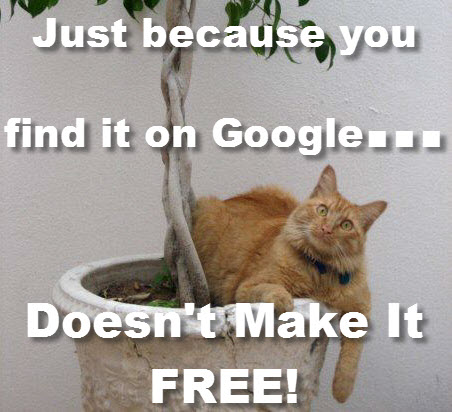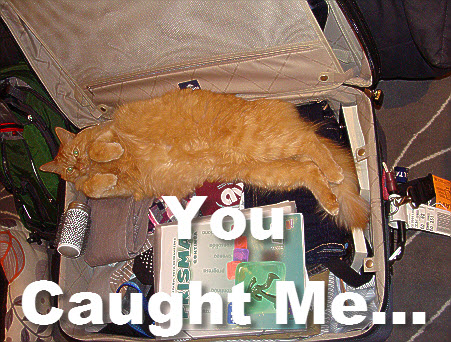Lately, we’ve been hearing more and more about digital copyrights and fair use in the news and online – particularly with the whole SOPA/PIPA uproar that recently swept the web.
Also, we on the Edublogs support team have been getting more and more complaints and official requests to remove copyrighted content that users have placed on blogs.
The legal jargon with respect to digital copyrights can be confusing – especially since different countries have their own laws and regulations.
With this post, we hope to dispel a few myths and pull together a complete list of resources for teachers and students to use when blogging and working with content online.
Rule #1: You Can’t Use Everything You Find On the Web

This may seem obvious, but judging by the notices we have received, many teachers (and especially students) are under the impression that if it is on the web, then it is up for grabs.
If you and your students keep rule #1 in mind, then everything else should be fine.
Rule #2: There Are Resources You CAN Use
One of the myths out there is that you can’t use any image, video, or content from another website on your blog.
That simply isn’t true, and we’ll cover our favorite sources of “fair use” and “public domain” sources at the end of this post.
It is troubling that while copyright is important to protect the hard work of others, it can also stifle creativity and hamper educational goals. Though SOPA is effectively dead at the moment, there is a legitimate need for newer laws that are built around the open and free-sharing nature of the web.
Understanding Fair Use
You might be aware that as educators, we have a few more flexible rules, called “Fair Use”, to play by.
That is, in some cases, if an image, text, video, etc. is being used for educational purposes, there might be more flexible copyright rules.
For example, a video that was purchased in a store can usually be shown in a classroom when the video is tied to the curriculum being taught. Otherwise, showing a class full of students a video would be considered a “public performance” and would be against the law.
The trouble is, most of the laws and rules that cover fair use and education were written well before the invention of the web.
While a textbook or curricula resource might allow for photocopying for classroom use, it most likely isn’t going to allow you to make a PDF of the document and put it on your class blog or website for students to print themselves.
The end result would be the same, right? A student would have a printed copy.
But make sure to check specific copyright restrictions before uploading anything you’ve scanned to the web!
For more, check out the Fair Use FAQ for Educators here from the excellent resource site, TeachingCopyright.org.
What Can Be a Violation?
Here are the most common types of content that we have been contacted about and asked to remove on our blogs:
- Images – mostly found through google image search
- Curriculum docs – especially handouts and student activities
- Text and quotes – copy/pasted from other websites (even with a link or attribution it still may not be legal)
- Music – usually mp3s that students have uploaded to share on their blogs
But I Won’t Be Caught…
If only that were true.
Google makes it incredibly easy for companies and content creators to seek out those posting their work on the web.
Sadly, we are also noticing more and more “law firms” and organizations out there looking for copyrighted content as a way of generating business. They then contact the copyright holder offering their services to get the content removed (for a fee of course).
It is a ruthless (and apparently profitable) practice, and we’d be lying if we haven’t argued with a few that contact Edublogs about how they are hurting the education of students. But let’s keep on topic…
What If I Am Caught?

Well of course in this case a good offense is your best defense. Check your blogs and class websites for any potentially offending material. If you find anything, just remove it.
The law requires copyright holders to give you (and the host of your site, such as Edublogs, WordPress, etc.) an official notification. Take these seriously and act quickly to remove what they want if you are in the wrong. That should be the end of it.
We were recently notified about a teacher with a blog on Edublogs that had a harmless world map image on his blog that he had presumably found using Google image search. When we contacted him telling him why we had removed the image, he asked if he and his students could write an apology letter to the copyright holder.
It was excellent – turning what could be a bit of an embarrassing mistake into a teachable moment for his students! Now this teacher had a good reason to discuss copyright and creative commons with his students…
So What Is Creative Commons?
One thing to look for when figuring out if a resource (ie. image, video, text, etc.) is free to copy or embed on your blog, is a Creative Commons license.
For example, look at the bottom right corner of the sidebar of this blog. You’ll see that we license all content on this blog as “Attribution – Non-Commercial – Share Alike”.
That is fancy talk for letting you know that you are free to use anything on this blog as long as you:
- give an attribution or credit that lets others know where you got the info with a link,
- won’t profit in any way from using our content and use it for non-business purposes only, and
- anything you create with our content, you must use the same license.
Luckily, the CreativeCommons.org website has a ton of excellent information and makes it easy to grab the license you wish to have on your own blog. If you (or your students) have blogs, then it is a good idea to choose the most appropriate license and make it visible on your blog.
In our case, we pasted the code they provided into a blank text widget in our sidebar.
Where To Find The Goods

Images
Creative Commons Search – Search many sites at once *Our Favorite!
StockVault.net – Free images from photographers around the world
Kozzi.com – One free photo per day
FindIcons.com – Huge resource for avatars or small images
Flickr Advanced Search – Use advanced search filters to show only CC licensed images
Morguefile – Free stock photos (Thanks Sue Lyon-Jones for link in comments!)
Open Clipart Libary – Public domain clipart (Thanks Sue Lyon-Jones for link in comments!)
Videos
You are free to embed any video from YouTube, Vimeo, WatchKnowLearn, etc. on your blog or website as long as it gives you the embed option.
That being said, you (or your students) can’t necessarily use parts from videos on YouTube (or other sources) to make mashups or as part of another video. Be sure to have permission to use any video that you are cutting, making changes to, or adding to a project.
Curriculum and Text
Wikipedia – Quote away (with a link back) to any information you find on Wikipedia
Curriki – An open curriculum community
Collaborize Classroom Library – A growing resource for discussion questions, lesson plans, and more
You won’t be able to add student resources from most textbook companies or purchased curriculum – so be careful and make sure you have permission before doing so!
Related Posts and More Info on Copyright
How To Attribute Copyrighted Works
Larry Ferlazzo’s Best Lists: Learning about copyright, best places for images, and best places for audio
Answering Reader Questions
(Edit: 2/22/2012 – This section was added to include responses to comments and tweets we’ve received since publishing the post)
In private or for-profit institutions, how can we use images and video, if at all? Is it even okay to use YouTube videos in class? What about online articles? Is there a difference between a class of paying students and a training delivered to teachers?
First, any images, videos, or content under a Creative Commons license will let you freely use the material with your student, you just may not be able to turn around and sell any changes you make. Any video on YouTube should be fine for showing in class, and if an image is on the web, you can always display the website that contains the image – where the line is drawn is on copying that image and pasting it on your own blog or website.
Can the onus not be placed on those who post these potential classroom materials, to make it clear who can and can´t or used for and not used for, surely this would be the least time consuming option.
Excellent point! Awareness of copyright and the importance of website owners to make it clear their licenses is improving. I think sticking to trusted sources and using filtered searches is the safest option.
If you can’t use images from the internet why is it that google can group all the images together for people to use?
Interesting thought for sure. Website owners can ask Google not to index their sites and images with a quick code. For bloggers, under Settings > Privacy, users can do the same thing. Not sure that really answers your question though 🙁
Is there a straightforward way to get the permission needed to use a ‘clip’ from a you tube video?
I’ve seen people leave a comment on the YouTube post, but there is no guarantee you’ll get a response.
Some YouTube videos are licensed under a Creative Commons license, and there is an advanced search filter on YouTube that would let you search for these. If you find one, you could use it without permission as long as you follow what the license allows (ie. provide attribution and not make money on the project).
What about the LIBRARY!?
Not so much a question, but Elijah left an excellent comment down below remind us that this is exactly why our libraries can be such valuable resources. Libraries have access to tons of licensed materials and librarians are specially trained to help us navigate the difficult copyright laws. Thanks, Elijah, for the tip!
When I get permission to post something that’s been copyrighted, am I supposed to share it a certain way so others that I have permission to use?
The answer here really depends on the license of the original content and the agreement you have with the original owner. Most of the time a link back to the original works perfect. The location of the link could be in an image caption, in the text itself, or at the end of your piece (like the “References” section of a formal paper).
Maybe APA/MLA/etc. should come out with a set of web publishing guidelines that include citations and reference lists! How would something like that even get started?
Can students read published books aloud, record themselves & publish recording on class blog?
The answer to this is probably not 🙁
However, many books are in the public domain – including most books written before the 1930s. These are all of the free books you see in the e-reader stores. Students would be free to record themselves and publish any book in the public domain. It should say somewhere near the beginning of the book if it is in the public domain (where copyright and publisher information usually goes).
What Do You Think?
Have we missed any important tips or good sites to find resources that are free to use?
Let us know in the comments below and we will be sure to add it to the post!

Hi Ronnie,
Amazing blog. Just one qustion. Will it be legal to create caricature of movie or television stars and sell it for commercial purpose via posters, notebooks and other mediums?
Hi Rahul,
Unfortunately I’m not totally sure of the answer to your question. Hopefully someone else reading may be know more than me.
If I send in photos to be considered for a project, can those images be used without my permission or does sending them in count as my consent?
I think usually sending them in would count as your consent, but it would most likely depend on the terms and conditions of the project. They should make it clear when you submit or have a way for you to ask directly.
As usual, it depends. What are the terms of the project? A submission could imply consent but should also be explicitly expressed as part of the deal, and it should not in any way imply you are transferring ownership.
I’m not sure why you say “Any video on YouTube should be fine for showing in class”. What is your authority, please? YouTubes Terms of Service specifically say in paragraph 5b “You may access Content for your information and PERSONAL use …” (capitalization of “personal” added by me for emphasis. So, you can’t claim rights from YouTube. Are you claiming “Fair Use” permissions? If so, you need to significantly caveat your statement because that is not a blanket “Any video on YouTube” kind of application.
I am a teacher- If I wanted to make a blog of children’s writing, what pemission would I need to obtain? Paretal presumably?? Any advice or experience greatly wecolme, thank you.
Hi Clare
Each school and school district varies. Some schools don’t require any permission to be obtained while others do. The best option is to ask if your school has parental consent forms that need to be completed. Even if parental consent isn’t required teachers will often send how information to inform parents of why they are using a blog and what is involved.
You can learn more about blogging with students here – http://teacherchallenge.edublogs.org/challenges-2/blogging-with-students/
I am not sure if this was covered but i am a college student and i recently bought a textbook : “Children” by Santrock, John i want to scan the whole book because it is very big and it would be easier to have it on my laptop. And not carry it.I am only planning to use it for my own use.
hi ronnie,
finally a clearly written article on this issue. thank you.
re: the reading aloud of text: what if i read *my written summary* of a chapter of a book, or short work like an academic paper, and record a video of the reading aloud of my summary & post it on the internet? it is my interpretation & explanation of the original work, but it is the entirety of my video, usually only 2 to 5 minutes long. i give proper citation before reading, and link and type citation as well. shouldn’t this be enough, even if the original work says “all rights reserved…no part..may be reproduced, stored…or transmitted in any form or by any means…”? it is my interpretation, after all.
thank you very much,
s
Hello, and thanks for continuing the conversation on this topic. I’d like to offer a correction and some answers to grey areas in your post:
“showing a class full of students a video would be considered a “public performance” and would be against the law.”— Not true, and very different from a public performance. Your classroom is not open to the public, but to a specific set of enrolled students. Section 110 is the exemption specifically for a huge variety of classroom uses of copyrighted material, as long as use is in the course of mediated instructional activities.
“If you can’t use images from the internet why is it that google can group all the images together for people to use?” — Because Google’s use (and it is definitely copying) is a transformative, original arrangement of information. A good example of copyrighted material being using in a non-infringing way, for a decidedly commercial purpose.
“Can students read published books aloud, record themselves & publish recording on class blog? The answer to this is probably not :(” — A large portion of these issues come down to making content publicly available, and if student videos are private and available only to other students in their course, then this would favor a fair use, just as reading aloud in a classroom would be allowed. If we are living in a world where students in a class are prohibited from reading aloud from their books, then please kill me now.
If anyone is interested in a facebook discussion about this topic, join our Fb group called Copyright Talk. Thanks.
I have a tough question. If a company sells a textbook, and provides accompanying materials with the textbook, can they dictate how I teach those materials, if everyone has purchased the copyrighted textbook from them.
ie. Can a publisher say “you can only teach this class to students in your physical location, but you cannot teach them from my book via a live internet broadcast” even if the person on the other end has also purchased a physical copy of the work?
I would assume that as long as every person learning from the content has purchased from the copyright holder, then it’s fair use.